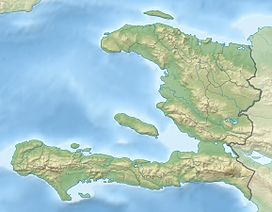| Massif de la Hotte | |
|---|---|
 Part of the Central Massif de la Hotte , the Tête Bœuf mountain chain seen from Bonnet Carre Haiti. | |
| Highest point | |
| Peak | Pic Macaya |
| Elevation | [1] |
| Prominence | 2,097 m (6,880 ft)[1] |
| Coordinates | 18°22′57″N 74°01′30″W / 18.38250°N 74.02500°W[1] |
| Dimensions | |
| Length | 200 km (120 mi) |
| Geography | |
| Country | Haiti |
| Continent | North America |
The Massif de la Hotte is a mountain range in southwestern Haiti, on the Tiburon Peninsula.[2] About 2.5 million years ago, Massif de la Hotte was separated from the Massif de la Selle by a deep, wide sea channel, and formed a separate island. This resulted in a hotbed of endemism in la Hottes bird, plant, and reptile communities.[3] The Massif de la Hotte is subdivided into the Oriental la Hotte in the East, the central la Hotte and the Occidental la Hotte on the Western tip of the Tiburon peninsula. The Occidental la Hotte is relatively remote and is one of the most biologically diverse and significant areas of all of Hispaniola. It also supports some of the last stands of Haiti's dense cloud forest on its peaks.
Haiti has a World Heritage Site located here.[4] In the wake of the 2010 Haiti earthquake, UNESCO's World Heritage Program is helping Haiti assess the damage.[5]
- ^ a b c "Central America and Caribbean Ultra-Prominence Page". peaklist.org. Retrieved 2022-09-26.
- ^ Woodring,Brown,Burbank. "Geology of the Republic of Haiti". Retrieved 2021-10-28.
{{cite web}}: CS1 maint: multiple names: authors list (link) - ^ Andrea Townsend. "Endangered Areas". Retrieved 2007-06-11.
- ^ "National History Park – Citadel, Sans Souci, Ramiers". UNESCO.org. Retrieved 23 January 2010.
- ^ "World Heritage in Haiti". UNESCO.org. 2010-01-20. Retrieved 23 January 2010.
